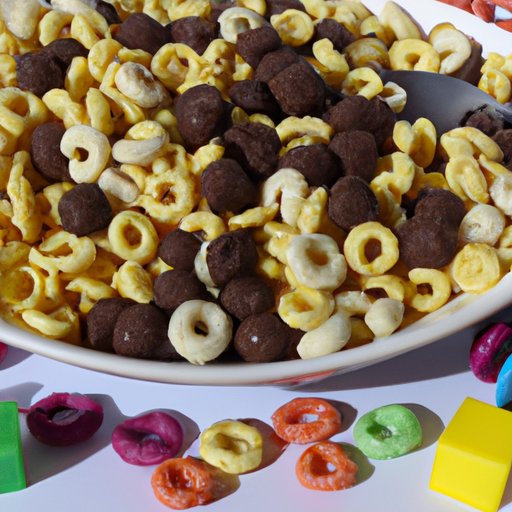Introduction
Cereal is one of the most popular breakfast foods in the world. It comes in many different varieties, from crunchy granola to sweetened puffs to hearty flakes. People of all ages enjoy cereal for its convenience, taste, and easy-to-digest nature. But is eating cereal actually healthy? In this article, we’ll explore the pros and cons of eating cereal and look at how it fits into a balanced diet.

Analyzing the Nutritional Profile of Cereal
When it comes to assessing the health benefits of eating cereal, the first step is to examine its nutritional profile. The macronutrients found in cereal vary depending on the type of cereal you choose. Most cereals are high in carbohydrates, with some containing up to 75% of their total calories coming from carbs. They also contain small amounts of protein and fat.
In terms of micronutrients, cereals are generally rich in vitamins and minerals. Some cereals are fortified with additional vitamins and minerals such as iron, zinc, and vitamin A. Additionally, some cereals may be enriched with omega-3 fatty acids, which are essential for heart health.
There are also certain types of cereals that offer specific health benefits. For example, oatmeal is high in dietary fiber, which helps to promote digestive health and regularity. Other types of cereals may contain probiotics, which can help to maintain a healthy balance of gut bacteria.

Exploring the Pros and Cons of Eating Cereal
When it comes to the health benefits of eating cereal, there are both pros and cons to consider. Let’s take a look at each side of the debate.
Discussing the Potential Health Benefits of Eating Cereal
Eating cereal can provide a variety of health benefits. As mentioned above, certain types of cereals may be enriched with omega-3 fatty acids, probiotics, and other nutrients that are essential for good health. Additionally, eating cereal can be an easy way to get the recommended daily amount of whole grains. Whole grains are important for maintaining a healthy weight and reducing the risk of chronic disease.
Examining the Potential Drawbacks of Eating Cereal
While there are certainly some health benefits associated with eating cereal, there are also potential drawbacks. Many popular brands of cereal are high in added sugars, which can increase your risk of developing obesity, diabetes, and other chronic diseases. Additionally, some cereals may contain artificial flavors and colors, which can have adverse effects on your health.
Examining the Role of Cereal in a Healthy Diet
When it comes to incorporating cereal into a healthy diet, moderation is key. Eating too much cereal can lead to weight gain and other health issues. The American Heart Association recommends limiting your intake of added sugars to no more than 25 grams per day. When choosing a cereal, look for one that is low in added sugars and high in fiber.
When it comes to portion size, the recommendation is to eat 1 cup of cereal per serving. However, this amount can vary depending on the type of cereal you choose. For example, some cereals may contain more calories per cup than others. Be sure to read the nutrition facts label to determine the calorie content of your cereal.

Comparing Different Types of Cereal
When it comes to choosing a cereal, it’s important to understand the differences between hot and cold cereals. Hot cereals, such as oatmeal and cream of wheat, are cooked with water or milk and typically contain more fiber than cold cereals. Cold cereals, such as corn flakes and bran flakes, are usually ready-to-eat and may contain added sugars.
In addition to hot and cold cereals, there is also a wide variety of flavors and textures to choose from. Some cereals are crunchy, while others are chewy. Some are sweet, while others are savory. There is truly something for everyone when it comes to cereal.
Investigating the Impact of Sugar Content on Cereal Health Benefits
As mentioned above, many popular brands of cereal are high in added sugars. While these cereals may be tasty, they are not necessarily healthy. Eating too much sugar can lead to weight gain and an increased risk of developing diabetes and other chronic diseases.
On the other hand, there are some cereals that are lower in sugar. These cereals may contain natural sweeteners such as honey or molasses, or they may contain no added sugars at all. Eating these types of cereals can be a healthier option and may even provide some health benefits.
Looking at How to Prepare Healthy Cereal Meals
Eating cereal doesn’t have to mean just eating a bowl of cereal with milk. There are plenty of ways to make healthy cereal meals. For example, you can top your cereal with fresh fruit, nuts, and seeds for a nutritious and delicious breakfast. You can also use cereal as an ingredient in recipes such as muffins, pancakes, and granola bars.
It’s also important to practice portion control when preparing cereal-based meals. Eating too much cereal can lead to weight gain and other health issues. Aim to keep your servings of cereal to about 1 cup per meal.
Conclusion
In conclusion, eating cereal can be a healthy part of a balanced diet. However, it’s important to choose the right type of cereal and practice portion control. Look for cereals that are low in added sugars and high in fiber, and limit your servings to about 1 cup per meal. By following these tips, you can enjoy the taste and convenience of cereal without compromising your health.
(Note: Is this article not meeting your expectations? Do you have knowledge or insights to share? Unlock new opportunities and expand your reach by joining our authors team. Click Registration to join us and share your expertise with our readers.)
